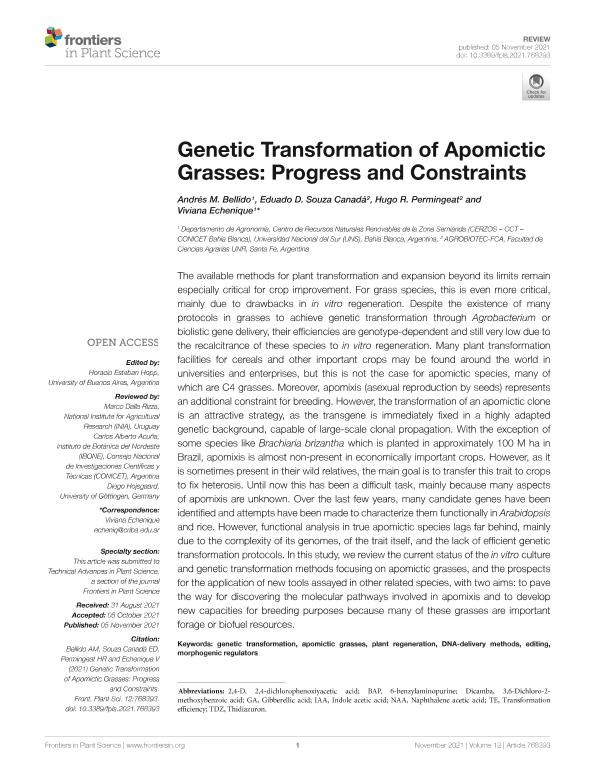Artículo
Genetic Transformation of Apomictic Grasses: Progress and Constraints
Fecha de publicación:
11/2021
Editorial:
Frontiers Media
Revista:
Frontiers in Plant Science
ISSN:
1664-462X
e-ISSN:
1664-462X
Idioma:
Inglés
Tipo de recurso:
Artículo publicado
Clasificación temática:
Resumen
The available methods for plant transformation and expansion beyond its limits remain especially critical for crop improvement. For grass species, this is even more critical, mainly due to drawbacks in in vitro regeneration. Despite the existence of many protocols in grasses to achieve genetic transformation through Agrobacterium or biolistic gene delivery, their efficiencies are genotype-dependent and still very low due to the recalcitrance of these species to in vitro regeneration. Many plant transformation facilities for cereals and other important crops may be found around the world in universities and enterprises, but this is not the case for apomictic species, many of which are C4 grasses. Moreover, apomixis (asexual reproduction by seeds) represents an additional constraint for breeding. However, the transformation of an apomictic clone is an attractive strategy, as the transgene is immediately fixed in a highly adapted genetic background, capable of large-scale clonal propagation. With the exception of some species like Brachiaria brizantha which is planted in approximately 100 M ha in Brazil, apomixis is almost non-present in economically important crops. However, as it is sometimes present in their wild relatives, the main goal is to transfer this trait to crops to fix heterosis. Until now this has been a difficult task, mainly because many aspects of apomixis are unknown. Over the last few years, many candidate genes have been identified and attempts have been made to characterize them functionally in Arabidopsis and rice. However, functional analysis in true apomictic species lags far behind, mainly due to the complexity of its genomes, of the trait itself, and the lack of efficient genetic transformation protocols. In this study, we review the current status of the in vitro culture and genetic transformation methods focusing on apomictic grasses, and the prospects for the application of new tools assayed in other related species, with two aims: to pave the way for discovering the molecular pathways involved in apomixis and to develop new capacities for breeding purposes because many of these grasses are important forage or biofuel resources.
Archivos asociados
Licencia
Identificadores
Colecciones
Articulos(CCT - BAHIA BLANCA)
Articulos de CTRO.CIENTIFICO TECNOL.CONICET - BAHIA BLANCA
Articulos de CTRO.CIENTIFICO TECNOL.CONICET - BAHIA BLANCA
Articulos(CERZOS)
Articulos de CENTRO REC.NAT.RENOVABLES DE ZONA SEMIARIDA(I)
Articulos de CENTRO REC.NAT.RENOVABLES DE ZONA SEMIARIDA(I)
Citación
Bellido, Andres; Souza Canadá, Eduado D.; Permingeat, Hugo Raúl; Echenique, Carmen Viviana; Genetic Transformation of Apomictic Grasses: Progress and Constraints; Frontiers Media; Frontiers in Plant Science; 12; 11-2021; 1-19
Compartir
Altmétricas




